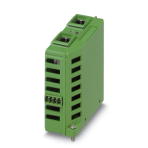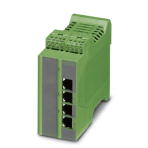Brief introduction of power over Ethernet Technology
Power over Ethernet PSE module with PoE interface
POE (Power Over Ethernet) refers to the existing Ethernet Cat.5 routing infrastructure does not do what changes to the case, as some in the terminal based on IP (such as IP telephone, AP wireless LAN access point, network camera) for the transmission of data signals at the same time, also can provide the DC power supply technology for this kind of equipment. POE technology can ensure the safety of the existing structured cabling and ensure the normal operation of the existing network, minimizing the cost of.
POE is also known as the power supply system based on LAN (POL, Power over LAN) or active Ethernet (Active Ethernet), is also sometimes referred to as the power over Ethernet, this is the use of existing standard Ethernet transmission cable at the same time the latest standards data transmission and power specifications, and keep up with the existing Ethernet system and users compatibility. IEEE 802.3af standard is a new standard for Ethernet power supply system based on POE, which based on the IEEE 802.3 by adding the relevant standard of direct power supply cable, is to extend the existing Ethernet standards, is the first international standard about power distribution.
IEEE began to develop the standard, but in 1999, the standard restricts the expansion of the market. Until 2003 June, the IEEE approved 3af standard 802, it clearly defines the power detection and control matters remote system, and the power supply switches and hubs, routers, telephone to the IP through the Ethernet cable safety system and wireless LAN access point device in this regulation. Development of IEEE 802.3af contains many company experts efforts, it also makes the standard can be tested in all aspects.
A typical Ethernet power supply system. Retention of Ethernet switch equipment in distribution cabinet, with a belt of supply hub (Midspan HUB) to provide power to the twisted pair lan. At the end of the twisted pair, the power used to drive the telephone, wireless access points, cameras and other equipment. In order to avoid power, can choose a UPS.
The composition and characteristics of POE power supply system parameters
A complete POE system includes a power supply terminal equipment (PSE, Power Sourcing Equipment) and the receiving end device (PD, Power, Device) the two part. The PSE device is for power over Ethernet client devices, but also the whole process of POE Ethernet power management. The PD device is receiving power PSE load, i.e. POE system client devices, such as IP telephone, network security camera, AP and Pocket PC (PDA) or a mobile phone charger and so many other Ethernet device (in fact, any power not more than 13W can obtain the corresponding power from the RJ45 outlet). Both the IEEE based on 802.3af standards related to the establishment of the receiving end device PD connections, the type of equipment and power level and other aspects of the contact information, and according to the PSE power supply to PD through ethernet.
The main power supply parameters of power supply system for POE standard:
The 1 voltage between 44 ~ 57V, the typical value is 48V.
2 the maximum allowed current is 550mA, the maximum starting current is 500mA.
3 typical operating current of 10 ~ 350mA, 350 ~ 500mA, current overload detection.
4 under no load condition, the maximum current required for 5mA.
5 for the PD device to provide 3.84 ~ five 12.95W grade electric power request, the maximum not exceeding 13W.
The working process of 2 POE power supply
When the PSE power supply terminal equipment arranged in a network, POE power over Ethernet work process is as follows.
1 detection: in the beginning, voltage of the PSE device is small in the output ports, until the detected connection cable terminal for receiving end equipment of a support IEEE 802.3af standard.
The 2 PD terminal equipment classification: when detected after receiving end PD equipment, PSE equipment may be for PD equipment classification, and evaluate the power loss of the PD equipment required.
Power supply: 3 start in a configurable time (typically less than 15 s) startup period, PSE equipment from the low voltage power supply to provide PD equipment, until the 48V DC power supply.
4: DC power supply provides a stable and reliable 48V for PD equipment, PD equipment to meet the power not to cross the consumption of 15.4W.
5 off: if PD equipment disconnecting from the network, PSE will quickly (generally in the 300 ~ 400ms) and stops supplying power to the PD device, and duplicate detection process to terminal to detect whether the PD cable connection device.
3 POE by the principle of power cable
Category five cable standard has four twisted pairs, but in the l0M BASE-T and 100M BASE-T only two of them on the. IEEE80 2.3af allows the two usage, application of spare power supply, 5 feet, 4 feet connected as cathode, 7, 8 legs are connected as a cathode.
Application of data foot power supply, DC power transmission transformer with at the midpoint, does not affect the transmission of the data. In this way, the 2 and 1 line to line on the 3 and 6 can be any polarity.
The standard does not allow the simultaneous application of the above two kinds of circumstances. Power supply device PSE can only provide a usage, but the power device PD applications must be able to also adapt to two kinds of circumstances. The standard power supply is usually 48V, 13W. Provide the conversion of 48V to PD low voltage apparatus is easy, but at the same time should be 1500V insulation safety voltage.
Two power supply method for POE
The POE standard for the transmission cable with Ethernet transport DC to POE compatible device defines two methods: one is called "mid span" (Mid -Span), is not used to use Ethernet cable in the idle line pair to transmit DC, Endpoint to the appropriate PSE support POE function of the Ethernet switch, routers, hubs or other network switching equipment. Another method is the "end of cross connection" (End-Span), is a DC electric core line used in the transmission of data transmission at the same time, its transmission using different and Ethernet data signal frequency. Midspan PSE is a dedicated power management devices, usually and switches together. It corresponds to each port has two RJ45 ports, a short line connected to the switch, the other connecting the remote device. Can foreknow, End-Span will quickly get promotion, this is because the Ethernet data and transmission using a public line pairs, thus eliminating the need for special line set up independent transmission for the standard RJ-45 socket, the significance of only 8 core cable and related special major.
Power over Ethernet PSE module with PoE interface
The use of industrial Ethernet power supply module, first through the Ethernet connection (LAN) to realize the power and conventional data transmission in the industrial environment. The use of Ethernet electric IEEE standard 802.3 AF ethernet. Terminals, such as WLAN and bluetooth access point, IP telephone and IP camera, in the industrial environment is used more and more widely, can rapid economic connection.
以太网供电技术简介
以太网供电PSE模块PoE接口
POE (Power Over Ethernet)指的是在现有的以太网Cat.5布线基础架构不作做何改动的情况下,在为一些基于IP的终端(如IP电话机、无线局域网接入点AP、网络摄像机等)传输数据信号的同时,还能为此类设备提供直流供电的技术。POE技术能在确保现有结构化布线安全的同时保证现有网络的正常运作,最大限度地降低成本。
POE也被称为基于局域网的供电系统(POL, Power over LAN )或有源以太网( Active Ethernet),有时也被简称为以太网供电,这是利用现存标准以太网传输电缆的同时传送数据和电功率的最新标准规范,并保持了与现存以太网系统和用户的兼容性。IEEE 802.3af标准是基于以太网供电系统POE的新标准,它在IEEE 802.3的基础上增加了通过网线直接供电的相关标准,是现有以太网标准的扩展,也是第一个关于电源分配的国际标准。
IEEE在1999年开始制定该标准,但是,该标准的缺点一直制约着市场的扩大。直到2003年6月,IEEE批准了802. 3af标准,它明确规定了远程系统中的电力检测和控制事项,并对路由器、交换机和集线器通过以太网电缆向IP电话、安全系统以及无线LAN接入点等设备供电的方式进行了规定。IEEE 802.3af的发展包含了许多公司专家的努力,这也使得该标准可以在各方面得到检验。
一个典型的以太网供电系统。在配线柜里保留以太网交换机设备,用一个带电源供电集线器(Midspan HUB)给局域网的双绞线提供电源。在双绞线的末端,该电源用来驱动电话、无线接入点、相机和其他设备。为避免断电,可以选用一个UPS。
POE的系统构成及供电特性参数
一个完整的POE系统包括供电端设备(PSE, Power Sourcing Equipment)和受电端设备(PD, Power Device)两部分。PSE设备是为以太网客户端设备供电的设备,同时也是整个POE以太网供电过程的管理者。而PD设备是接受供电的PSE负载,即POE系统的客户端设备,如IP电话、网络安全摄像机、AP及掌上电脑( PDA)或移动电话充电器等许多其他以太网设备(实际上,任何功率不超过13W的设备都可以从RJ45插座获取相应的电力)。两者基于IEEE 802.3af标准建立有关受电端设备PD的连接情况、设备类型、功耗级别等方面的信息联系,并以此为根据PSE通过以太网向PD供电。
POE标准供电系统的主要供电特性参数为:
1. 电压在44~57V之间,典型值为48V。
2. 允许最大电流为550mA,最大启动电流为500mA。
3. 典型工作电流为10~350mA,超载检测电流为350~500mA。
4. 在空载条件下,最大需要电流为5mA。
5. 为PD设备提供3.84~12.95W五个等级的电功率请求,最大不超过13W。
2. POE供电的工作过程
当在一个网络中布置 PSE供电端设备时,POE以太网供电工作过程如下所示。
1. 检测:一开始,PSE设备在端口输出很小的电压,直到其检测到线缆终端的连接为一个支持IEEE 802.3af标准的受电端设备。
2. PD端设备分类:当检测到受电端设备PD之后,PSE设备可能会为PD设备进行分类,并且评估此PD设备所需的功率损耗。
3. 开始供电:在一个可配置时间(一般小于15μs)的启动期内,PSE设备开始从低电压向PD设备供电,直至提供48V的直流电源。
4. 供电:为PD设备提供稳定可靠48V的直流电,满足PD设备不越过 15.4W的功率消耗。
5. 断电:若PD设备从网络上断开时,PSE就会快速地(一般在300~400ms之内)停止为PD设备供电,并重复检测过程以检测线缆的终端是否连接PD设备。
3. POE通过电缆供电的原理
标准的五类网线有四对双绞线,但是在l0M BASE-T和100M BASE-T中只用到其中的两对。IEEE80 2.3af允许两种用法,应用空闲脚供电时,4、5脚连接为正极,7、8脚连接为负极。
应用数据脚供电时,将DC电源加在传输变压器的中点,不影响数据的传输。在这种方式下线对1、2和线对3、6可以为任意极性。
标准不允许同时应用以上两种情况。电源提供设备PSE只能提供一种用法,但是电源应用设备PD必须能够同时适应两种情况。该标准规定供电电源通常是48V、13W的。PD设备提供48V到低电压的转换是较容易的,但同时应有1500V的绝缘安全电压。
POE的两种供电方法
POE标准为使用以太网的传输电缆输送直流电到POE兼容的设备定义了两种方法:一种称作“中间跨接法”( Mid -Span ),使用以太网电缆中没有被使用的空闲线对来传输直流电,相应的Endpoint PSE支持POE功能的以太网交换机、路由器、集线器或其他网络交换设备。另一种方法是“末端跨接法”(End-Span),是在传输数据所用的芯线上同时传输直流电,其输电采用与以太网数据信号不同的频率。Midspan PSE是一个专门的电源管理设备,通常和交换机放在一起。它对应每个端口有两个RJ45插孔,一个用短线连接至交换机,另一个连接远端设备。可以预见,End-Span会迅速得到推广,这是由于以太网数据与输电采用公用线对,因而省去了需要设置独立输电的专用线,这对于仅有8芯的电缆和相配套的标准RJ-45插座意义特别重大。
以太网供电PSE模块PoE接口
使用工业以太网供电模块,首次通过以太网连接(LAN)在工业环境中实现电源和数据常规传输。 使用以太网上电IEEE 802.3 af以太网标准。 端子,如WLAN和蓝牙接入点、IP电话和IP摄像头,在工业环境中使用越来越广泛,可快速经济地连接。

Figure 1 "mid span" (Mid -Span) using the FL PSE 2TX module
In hard to reach places of assembly, such as walls or roofs, may be excluded from the separate power supply connections; can be connected to provide power and data through LAN.
Can be completely omitted the installation cost of power supply equipment cost and related power supply terminal equipment. By using the central uninterruptible power supply (UPS), and even can improve fault redundancy capability of terminal.
图1 “中间跨接法”( Mid -Span )使用FL PSE 2TX模块
在难以触及的地方组装时,如墙壁或房顶,可排除单独的电源连接;可通过LAN连接提供电源和数据。
可完全省去在电源设备成本和相关电源终端设备的安装成本。 通过使用中央不间断电源(UPS),甚至可提高终端的故障冗余能力。

Figure 2 "end cross connection" (End-Span) FL IF 2PSE-F module, integrated in the module type management switch (MMS) in
图2“末端跨接法”(End-Span)FL IF 2PSE-F模块,集成在模组式管理交换机(MMS)中
Power over Ethernet PSE module with PoE interface
The model FL IF 2PSE-F FL PSE 2TX
Order No. 28329042891013
Description interface module for power over Ethernet, modular management type switch, the front end is connected with the 2xRJ45 (front) of power over Ethernet module (PSE), the 2xRJ45 connection, cross equipment 24VDC power supply
Technical parameters of the 2 PoE port, 10/100Mbps (connection direction forward) RJ45 hole plug, 2 PoE ports, 10/100Mbps (connection direction forward) 8 bit RJ45 hole plug,
Medium module, module for management type switch, accord with power over Ethernet IEEE802.3af, power supply equipment (PSE) PSE span, consistent with IEEE802.3af
(internal 48VDC for PoE 70g 24V DC (weight) by COMBICON; the maximum wire cross-sectional area 2.5mm2) weight 320G
"The end of cross connection" (End-Span) "mid span" (Mid -Span)
| 以太网供电PSE模块PoE接口 |
| 型号 |
FL IF 2PSE-F |
FL PSE 2TX |
| 订货号 |
2832904 |
2891013 |
| |
 |
 |
| 描述 |
以太网供电的接口模块,用于模块化管理型交换机,前端连接2xRJ45(前端) |
以太网供电模块(PSE),2xRJ45连接,中跨设备24VDC电源 |
| 技术参数 |
2个PoE口,10/100Mbps(连接方向向前)RJ45孔式插头, |
2个PoE口,10/100Mbps(连接方向向前)8位RJ45孔式插头, |
| 介质模块,用于模块化管理型交换机,符合以太网供电IEEE802.3af,电源设备(PSE) |
PSE中跨,符合IEEE802.3af |
| (内部48VDC用于PoE)重量70g |
24V DC(通过COMBICON;导线最大截面积2.5mm2)重量320g |
| |
 |
 |
| |
“末端跨接法”(End-Span) |
“中间跨接法”( Mid -Span ) |

